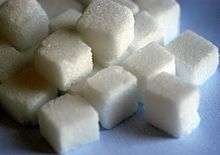Empty calorie

In human nutrition, the term empty calories applies to food such as solid fats or added sugars supplying food energy but little or no other nutrition. The USDA advises, "A small amount of empty calories is okay, but most people eat far more than is healthy."[1]
The phrase is derived from nutrient density (proportion of nutrients in a food relative to its energy content), and calorie density (amount of energy relative to weight of the food). Thus empty calories are accompanied by no or few nutrients.[2] Foods containing empty calories typically contain processed carbohydrates and ethanol (alcohol), and to some extent fats. Also known as a discretionary calorie, an empty calorie has the same energy content as any other calorie but lacks many accompanying nutrients such as vitamins, dietary minerals, antioxidants, amino acids, or dietary fiber. Although carbohydrates and fats are nutrients, they are typically ignored for this analysis, with the exception of essential fatty acids.
The error of considering energy foods as adequate nutrition was demonstrated by François Magendie by experiments on dogs and described in his Précis élementaire de Physiologie (1816). A book on sugar described the problem with empty calories as follows:[3]
- [A diet exclusively of] refined sugar is lethal when ingested by humans because it provides only that which nutritionists describe as empty or naked calories. In addition, sugar is worse than nothing because it drains and leeches the body of precious vitamins and minerals through the demand its digestion, detoxification, and elimination make upon one's entire system.
Examples
The following foods are often considered[4][5][6][7] to contain mostly empty calories and may lead to weight gain:
- Cake, cookies, sweets, candy, ice cream, soft drinks, fruit-flavored beverages and gelatin and other foods containing added sugars (including High-fructose corn syrup, HFCS)
- Margarine or shortening, and other fats and oils (although some consumption of fats is essential to health)
- Beer, wine, and other alcoholic beverages
Intake
All people require certain essential nutrients, but food energy intake must be balanced with activity to maintain a proper body weight. People who engage in heavy physical activity need food energy as fuel, which can be supplied by empty calories in addition to foods with essential nutrients. Sedentary individuals and those eating less to lose weight may suffer malnutrition if they eat food supplying empty calories but not enough nutrients.[8][9] Dietitians and nutritionists prevent or treat illnesses by designing eating programs and recommending dietary modifications according to patient's needs.[10] Eating a variety of nutritious foods every day protects against chronic illness and helps to maintain a healthy immune system.[11]
The USDA advises the following levels of empty calorie consumption by individuals who engage in moderate exercise of 30 minutes or less daily.[12]
| Gender | Age (years) | Total daily calorie needs | Daily limit for empty calories by |
|---|---|---|---|
| Male | 2-3 | 1000 | 135 |
| 4-8 | 1200-1400 | 120 | |
| 9-13 | 1800 | 160 | |
| 14-18 | 2200 | 265 | |
| 19-30 | 2400 | 330 | |
| 31-50 | 2200 | 265 | |
| 51+ | 2000 | 260 | |
| Female | 2-3 | 1000 | 135 |
| 4-8 | 1200-1400 | 120 | |
| 9-13 | 1600 | 120 | |
| 14-18 | 1800 | 160 | |
| 19-30 | 2000 | 260 | |
| 31-50 | 1800 | 160 | |
| 51+ | 1600 | 120 |
See also
References
- ↑ What are empty calories?
- ↑ Marion Nestle and Malden Nesheim (2013) Why Calories Count: From Science to Politics, page 3, ISBN 0520952170
- ↑ William Dufty (1975) Sugar Blues, page 137
- ↑ "What are Empty Calories?". Choosemyplate.gov. Retrieved 2013-05-21.
- ↑ "Beware-Empty-Calories". Webmd.com. Retrieved 2013-05-21.
- ↑ "Definition Of Empty Calories". Livestrong.Com. Retrieved 2013-05-21.
- ↑ "Which foods have empty calories?". Caloriecount.about.com. 2008-04-10. Retrieved 2013-05-21.
- ↑ "Healthy Weight: Caloric Balance | DNPAO | CDC". Cdc.gov. 2011-10-31. Retrieved 2013-05-21.
- ↑ "A Healthier You - Chapter 6. Calories + Nutrients = Food". Health.gov. Retrieved 2013-05-21.
- ↑ "Dietitians and Nutritionists : Occupational Outlook Handbook : U.S. Bureau of Labor Statistics". Bls.gov. 2012-07-18. Retrieved 2013-05-21.
- ↑ "Vitamin and Nutrient Information from the Academy". Eatright.org. Retrieved 2013-05-21.
- ↑ "Empty Calories: How Many Empty Calories Can I Have?". USDA MyPlate 2011. Retrieved 2014-01-22.
External links
- "Adequate Nutrients Within Calorie Needs". Dietary Guidelines for Americans 2005. Retrieved 2006-05-09.
- "Nutrient-dense food vs. empty-calorie food". Calorie Counter. Retrieved 2006-05-09.